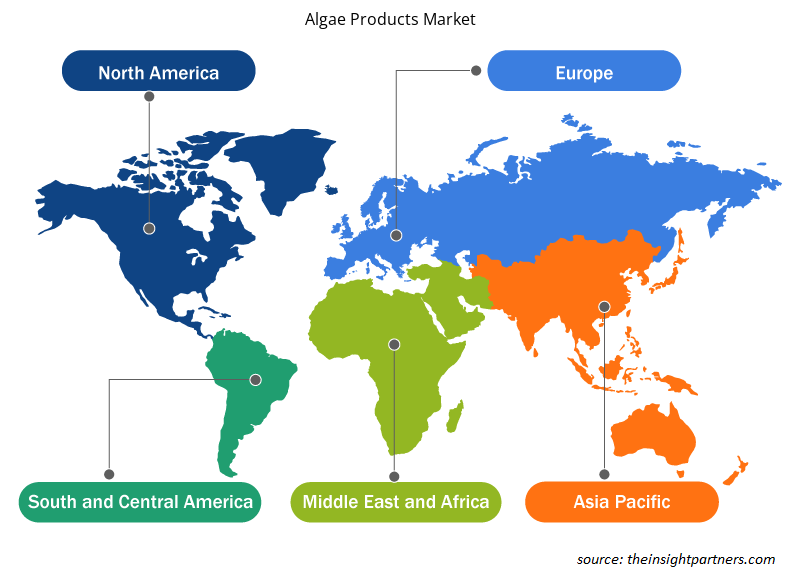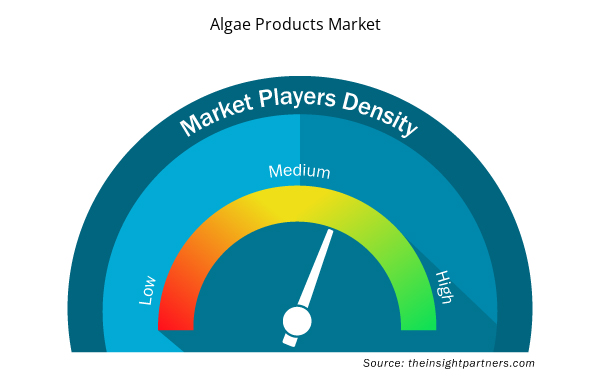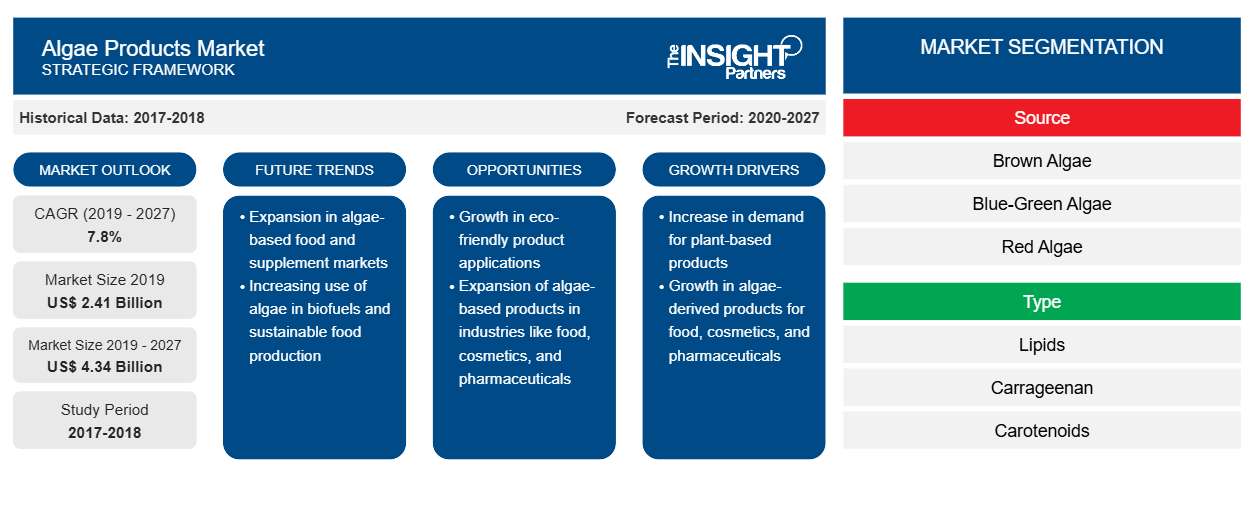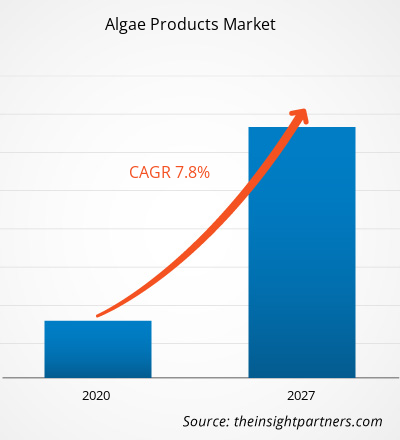[調査レポート] 藻類製品市場は2019年に24億550万米ドルと評価され、2027年には43億3930万米ドルに達すると予測されており、2020年から2027年にかけて7.8%のCAGRで成長すると予想されています。
藻類は、その多くの利点と生産の容易さから、燃料、食料、飼料、およびバイオマスや油のその他の副産物の最も有望な長期的かつ持続可能な供給源の 1 つとして浮上しています。藻類は、他の既知の自然または人工のプロセスとは異なり、エネルギーを効率的に生産および貯蔵するために 10 億年以上にわたって進化してきました。さらに、微細藻類は、バイオ燃料または動物飼料のいずれか、またはその両方を生産するために、タンパク質と油分を多く含むように栽培することができます。さらに、微量栄養素が豊富な微細藻類バイオマスは、すでに人間の健康を改善するための栄養補助食品として使用されています。食品市場で最も重要な用途は、微細藻類バイオマス全体を食品サプリメントとして使用することです。微細藻類は、カロテノイドやオメガ 3 脂肪酸などの食品成分の供給源としても使用されます。同様に、寒天は食品業界でゼラチンの代替品として使用され、クリーム、ソース、マヨネーズ、ゼリー、カスタード、プリン、プロセスチーズ、冷凍乳製品の製造に使用されています。また、ジャムやマーマレードのゲル化と増粘剤として、またパンやペストリーの乾燥防止剤としても使用されています。さらに、寒天はアイスクリームやその他のデザートの増粘剤としても使用されています。このように、藻類製品は代替食品源および食品成分として機能し、藻類製品市場の成長を牽引しています。
2019年に最も高い市場シェアを占めたのは北米でした。さらに、アジア太平洋地域は、予測期間、つまり2020年から2027年の間に有利な成長率を示すと予測されています。米国や世界の他の地域では、藻類は免疫システムの強化、神経組織の修復、血糖値の正常化、および体にタンパク質と繊維を追加するのに役立つ栄養補助食品として一般的に使用されています。藻類は、中国と日本で4,000年以上にわたって人間の食料として収穫されてきました。
要件に合わせてレポートをカスタマイズする
このレポートの一部、国レベルの分析、Excelデータパックなど、あらゆるレポートを無料でカスタマイズできます。また、スタートアップや大学向けのお得なオファーや割引もご利用いただけます。
- このレポートの主要な市場動向を入手してください。この無料サンプルには、市場動向から見積もりや予測に至るまでのデータ分析が含まれます。
COVID-19パンデミックが藻類製品市場に与える影響
米国は、カナダやメキシコと比較して、コロナウイルスの確認症例数が最も多い。パンデミックCOVID-19は、北米諸国で小売店や製造工場の一時的な閉鎖を余儀なくし続けており、前例のない商業の混乱を示唆している。小売業者やブランドは、健康と安全、サプライチェーン、労働力、キャッシュフロー、消費者需要、マーケティングに関するさまざまな短期的な課題に直面している。北米では、3月初旬に店舗の閉鎖が始まり、都市や州がウイルスの拡散を封じ込めようと奮闘する中、この傾向は続くと予想されている。さらに、COVID-19パンデミックは、デジタルコマースの伝統を急速に加速させている。人々が社会的距離を保つように勧告される中、医薬品や必需品の食品や飲料のeコマース注文は、北米の人々にとって生き残るための手段となっている。
市場分析
バイオ燃料市場における急成長
過去 10 年間、藻類業界はバイオ燃料市場の維持に苦戦してきました。しかし、メーカーが原材料製造、資本コスト、生産量に関連する重大な障壁を克服すれば、この製品は大きな可能性を秘めています。世界中でバイオ燃料の義務化が導入されると、メーカーは予測期間中に藻類燃料生産の持続可能な技術を開発するために研究開発にさらに投資せざるを得なくなると予想されます。さらに、バイオ燃料は、世界的なエネルギー危機と環境問題に対処するための再生可能エネルギーの最も有望な潜在的供給源の 1 つと考えられています。微細藻類バイオマスは、バイオ燃料、化学物質、バイオベースの製品を処理する能力を示しており、石油ベースの経済からバイオベースの経済への移行に貢献しています。藻類バイオ燃料には、食料との競争がなく成長率が高く、環境への影響が最小限またはまったくないなどの利点があります。微細藻類から生産されるバイオ燃料は、カロリー値の高いセルロース系バイオ燃料と比較して粘度と密度が低いため、藻類バイオ燃料の方が用途に適しています。
ソースベースの市場洞察
情報源によると、藻類製品市場は褐藻類、藍藻類、紅藻類、緑藻類、その他に分類されています。2019年には褐藻類セグメントが藻類製品市場をリードしました。
タイプベースの市場分析
藻類製品市場は、脂質、カラギーナン、カロテノイド、アルギン酸塩、藻類タンパク質、その他に分類されています。カロテノイドセグメントは、2019年に藻類製品市場をリードしました。
フォームベースの市場分析
藻類製品市場は、形態に基づいて固体と液体に細分化されています。2019 年には固体セグメントが藻類製品市場をリードしました。
アプリケーションベースの市場分析
藻類製品市場は、用途に基づいて、食品および飲料、栄養補助食品および栄養補助食品、パーソナルケア製品、飼料、医薬品、その他に分類されます。栄養補助食品および栄養補助食品セグメントは、2019年に藻類製品市場をリードしました。
有機的成長戦略は、企業が市場範囲を拡大するために一般的に採用されている戦略です。Cyanotech Corporation、DSM、および Algatech Ltd は、顧客基盤を拡大し、世界的に大きな市場シェアを獲得するためにこの戦略を実行している市場プレーヤーの一部であり、その結果、世界の藻類製品市場でブランド名を維持できるようになりました。
藻類製品市場の地域別洞察
予測期間を通じて藻類製品市場に影響を与える地域的な傾向と要因は、Insight Partners のアナリストによって徹底的に説明されています。このセクションでは、北米、ヨーロッパ、アジア太平洋、中東、アフリカ、南米、中米にわたる藻類製品市場のセグメントと地理についても説明します。

- 藻類製品市場の地域別データを入手
藻類製品市場レポートの範囲
| レポート属性 | 詳細 |
|---|---|
| 2019年の市場規模 | 24億1000万米ドル |
| 2027年までの市場規模 | 43億4千万米ドル |
| 世界のCAGR(2019年 - 2027年) | 7.8% |
| 履歴データ | 2017-2018 |
| 予測期間 | 2020-2027 |
| 対象セグメント | ソース別
|
| 対象地域と国 | 北米
|
| 市場リーダーと主要企業プロフィール |
|
藻類製品市場のプレーヤー密度:ビジネスダイナミクスへの影響を理解する
藻類製品市場は、消費者の嗜好の変化、技術の進歩、製品の利点に対する認識の高まりなどの要因により、エンドユーザーの需要が高まり、急速に成長しています。需要が高まるにつれて、企業は提供を拡大し、消費者のニーズを満たすために革新し、新たなトレンドを活用し、市場の成長をさらに促進しています。
市場プレーヤー密度とは、特定の市場または業界内で活動している企業または会社の分布を指します。これは、特定の市場スペースに、その市場規模または総市場価値に対してどれだけの競合相手 (市場プレーヤー) が存在するかを示します。
藻類製品市場で事業を展開している主要企業は次のとおりです。
- アルガテック株式会社
- アルジェノール
- BASF SE
- カーギル株式会社
- 株式会社セラナ
免責事項:上記の企業は、特定の順序でランク付けされていません。

- 藻類製品市場のトップキープレーヤーの概要を入手
藻類製品市場のセグメンテーション:
藻類製品市場 – 供給元別
- 褐藻
- 藍藻類
- 紅藻
- 緑藻
- その他
藻類製品市場 – タイプ別
- 脂質
- カラギーナン
- カロテノイド
- アルギン酸
- 藻類タンパク質
- その他
藻類製品市場 - 形態別
- 固体
- 液体
藻類製品市場 – 用途別
- 食品および飲料
- 栄養補助食品および栄養補助食品
- パーソナルケア製品
- 餌
- 医薬品
- 他の
企業プロフィール
- アルガテクノロジーズ株式会社
- アルジェノール
- BASF SE
- カーギル株式会社。
- 株式会社セラナ
- コービオン NV
- CPケルコ(JMフーバーコーポレーション
- シアノテック株式会社。
- DSMニュートリショナルプロダクツAG
- EID パリー リミテッド
- 過去2年間の分析、基準年、CAGRによる予測(7年間)
- PEST分析とSWOT分析
- 市場規模価値/数量 - 世界、地域、国
- 業界と競争環境
- Excel データセット



Report Coverage
Revenue forecast, Company Analysis, Industry landscape, Growth factors, and Trends

Segment Covered
This text is related
to segments covered.

Regional Scope
North America, Europe, Asia Pacific, Middle East & Africa, South & Central America

Country Scope
This text is related
to country scope.
よくある質問
The nutraceuticals and dietary supplements segment is the leading application in the market. Seaweeds are consumed in the form of nutraceuticals and dietary supplements, and complementary medicine across global. Algae became a promising source of ecological crops with several health benefits, which includes proteins such as antioxidants and Omega 3. The nutraceuticals and pharmaceutical industries make use of a considerable variety of algae species for the development of dietary supplements that are consumed by humans.
The North America region led the global algae products market in 2019. A rapid increase in the number of health diseases, such as heart diseases and obesity, has favored the demand for vegan seafood products, which shows substantial opportunities for the algae products market in North America.
Algae are emerging as one of the most promising long-term, sustainable sources of fuel, food, feed, and other co-products for biomass and oils due to a large number of benefits and ease of its production. Algae have evolved over a billion years to efficiently produce and store energy, unlike any other known natural or engineered process. Furthermore, microalgae can be grown to have a high protein and oil content in order to produce either biofuels or animal feeds, or both. Therefore, the alternate food source and food ingredient is driving the growth of algae products market across globe.
Trends and growth analysis reports related to Food and Beverages : READ MORE..
The List of Companies - Algae Products Market
- Algatech LTD
- Algenol
- BASF SE
- Cargill, Incorporated
- Cellana Inc.
- Corbion
- CP Kelco
- Cyanotech Corporation
- DSM
- E.I.D. - Parry (India) Limited
The Insight Partners performs research in 4 major stages: Data Collection & Secondary Research, Primary Research, Data Analysis and Data Triangulation & Final Review.
- Data Collection and Secondary Research:
As a market research and consulting firm operating from a decade, we have published and advised several client across the globe. First step for any study will start with an assessment of currently available data and insights from existing reports. Further, historical and current market information is collected from Investor Presentations, Annual Reports, SEC Filings, etc., and other information related to company’s performance and market positioning are gathered from Paid Databases (Factiva, Hoovers, and Reuters) and various other publications available in public domain.
Several associations trade associates, technical forums, institutes, societies and organization are accessed to gain technical as well as market related insights through their publications such as research papers, blogs and press releases related to the studies are referred to get cues about the market. Further, white papers, journals, magazines, and other news articles published in last 3 years are scrutinized and analyzed to understand the current market trends.
- Primary Research:
The primarily interview analysis comprise of data obtained from industry participants interview and answers to survey questions gathered by in-house primary team.
For primary research, interviews are conducted with industry experts/CEOs/Marketing Managers/VPs/Subject Matter Experts from both demand and supply side to get a 360-degree view of the market. The primary team conducts several interviews based on the complexity of the markets to understand the various market trends and dynamics which makes research more credible and precise.
A typical research interview fulfils the following functions:
- Provides first-hand information on the market size, market trends, growth trends, competitive landscape, and outlook
- Validates and strengthens in-house secondary research findings
- Develops the analysis team’s expertise and market understanding
Primary research involves email interactions and telephone interviews for each market, category, segment, and sub-segment across geographies. The participants who typically take part in such a process include, but are not limited to:
- Industry participants: VPs, business development managers, market intelligence managers and national sales managers
- Outside experts: Valuation experts, research analysts and key opinion leaders specializing in the electronics and semiconductor industry.
Below is the breakup of our primary respondents by company, designation, and region:

Once we receive the confirmation from primary research sources or primary respondents, we finalize the base year market estimation and forecast the data as per the macroeconomic and microeconomic factors assessed during data collection.
- Data Analysis:
Once data is validated through both secondary as well as primary respondents, we finalize the market estimations by hypothesis formulation and factor analysis at regional and country level.
- Macro-Economic Factor Analysis:
We analyse macroeconomic indicators such the gross domestic product (GDP), increase in the demand for goods and services across industries, technological advancement, regional economic growth, governmental policies, the influence of COVID-19, PEST analysis, and other aspects. This analysis aids in setting benchmarks for various nations/regions and approximating market splits. Additionally, the general trend of the aforementioned components aid in determining the market's development possibilities.
- Country Level Data:
Various factors that are especially aligned to the country are taken into account to determine the market size for a certain area and country, including the presence of vendors, such as headquarters and offices, the country's GDP, demand patterns, and industry growth. To comprehend the market dynamics for the nation, a number of growth variables, inhibitors, application areas, and current market trends are researched. The aforementioned elements aid in determining the country's overall market's growth potential.
- Company Profile:
The “Table of Contents” is formulated by listing and analyzing more than 25 - 30 companies operating in the market ecosystem across geographies. However, we profile only 10 companies as a standard practice in our syndicate reports. These 10 companies comprise leading, emerging, and regional players. Nonetheless, our analysis is not restricted to the 10 listed companies, we also analyze other companies present in the market to develop a holistic view and understand the prevailing trends. The “Company Profiles” section in the report covers key facts, business description, products & services, financial information, SWOT analysis, and key developments. The financial information presented is extracted from the annual reports and official documents of the publicly listed companies. Upon collecting the information for the sections of respective companies, we verify them via various primary sources and then compile the data in respective company profiles. The company level information helps us in deriving the base number as well as in forecasting the market size.
- Developing Base Number:
Aggregation of sales statistics (2020-2022) and macro-economic factor, and other secondary and primary research insights are utilized to arrive at base number and related market shares for 2022. The data gaps are identified in this step and relevant market data is analyzed, collected from paid primary interviews or databases. On finalizing the base year market size, forecasts are developed on the basis of macro-economic, industry and market growth factors and company level analysis.
- Data Triangulation and Final Review:
The market findings and base year market size calculations are validated from supply as well as demand side. Demand side validations are based on macro-economic factor analysis and benchmarks for respective regions and countries. In case of supply side validations, revenues of major companies are estimated (in case not available) based on industry benchmark, approximate number of employees, product portfolio, and primary interviews revenues are gathered. Further revenue from target product/service segment is assessed to avoid overshooting of market statistics. In case of heavy deviations between supply and demand side values, all thes steps are repeated to achieve synchronization.
We follow an iterative model, wherein we share our research findings with Subject Matter Experts (SME’s) and Key Opinion Leaders (KOLs) until consensus view of the market is not formulated – this model negates any drastic deviation in the opinions of experts. Only validated and universally acceptable research findings are quoted in our reports.
We have important check points that we use to validate our research findings – which we call – data triangulation, where we validate the information, we generate from secondary sources with primary interviews and then we re-validate with our internal data bases and Subject matter experts. This comprehensive model enables us to deliver high quality, reliable data in shortest possible time.


 このレポートの無料サンプルを入手する
このレポートの無料サンプルを入手する